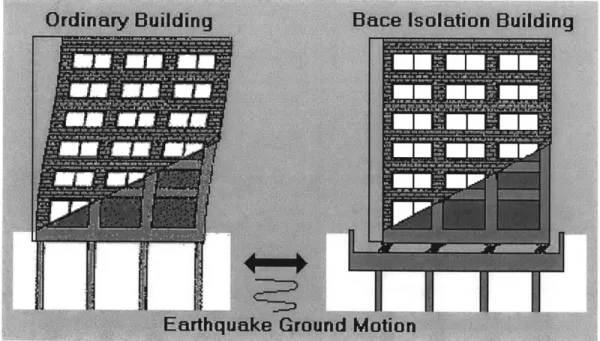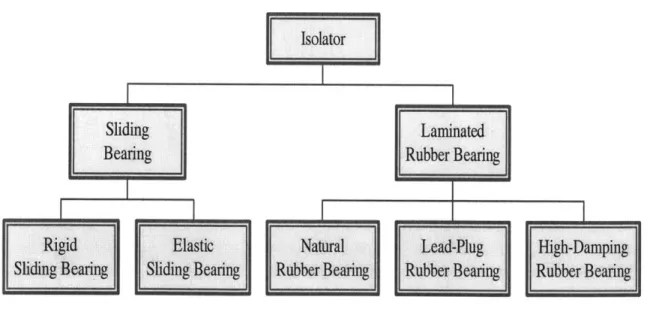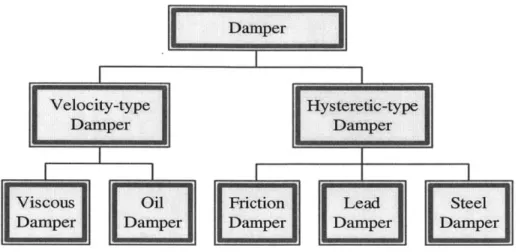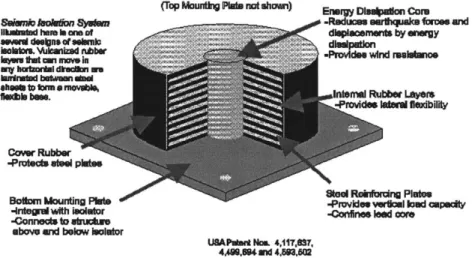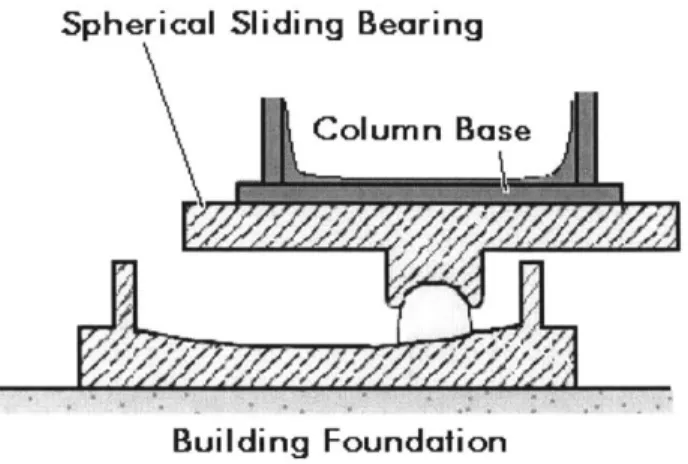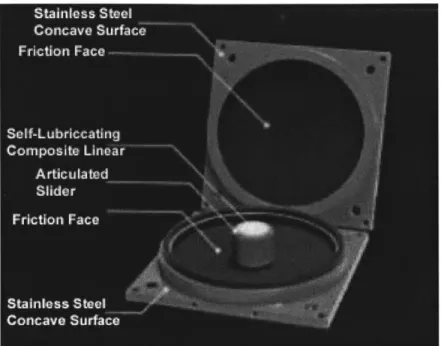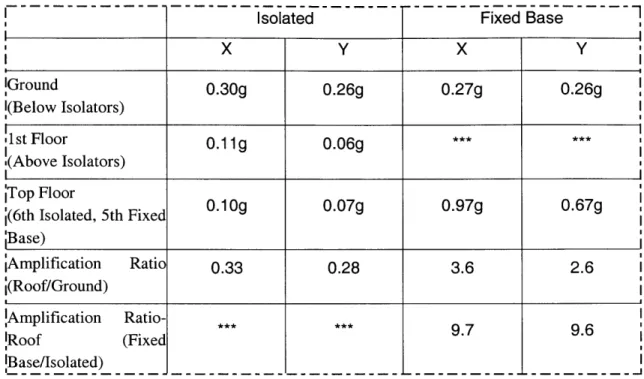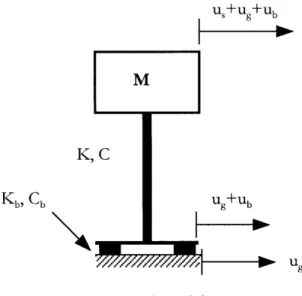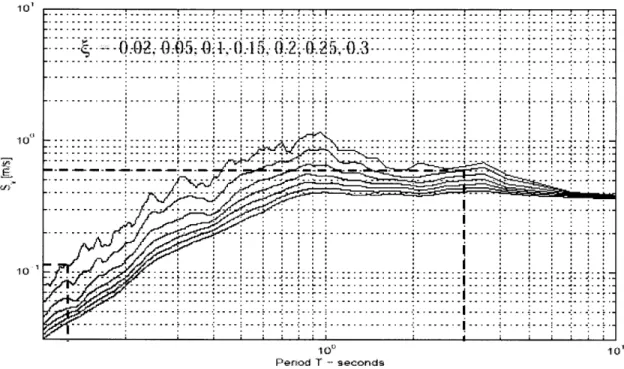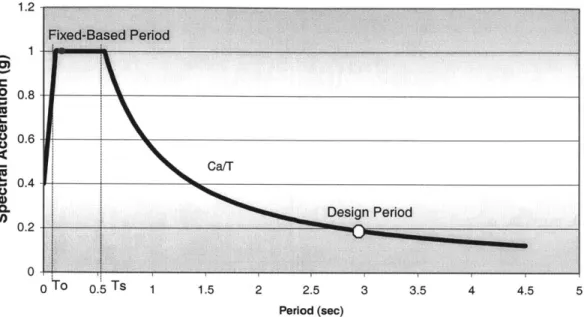DESIGN OF BASE ISOLATION SYSTEM FOR BUILDINGS
by Tai-Chieh Wu
Bachelor of Science in Civil Engineering Chung-Yuan Christian University, Chung-Li, Taiwan
SUBMITTED TO THE DEPARTMENT OF CIVIL AND ENVIRONMENTAL ENGINEERING IN PARTIAL FULFILLMENT OF THE REQUIREMENTS FOR THE
DEGREE OF
MASTER OF ENGINEERING
IN CIVIL AND ENVIRONMENTAL ENGINEERING at the
MASSACHUSETTS INSTITUTE OF TECHNOLOGY June 2001 MASSACHUSETTS INSTITUTE OF TECHNOLOGY
JUN 04?1
LIBRARIES
@2001 Tai-Chieh Wu All Rights Reserved.The author hereby grants MIT permission to reproduce and distribute publicly paper and electronic copies of this thesis document in whole or in part.
Signature of Author
Department of Civil and Environmental Engineering May 11, 2001
Certified by
Certified by
Accepted by
Or
l
Buyukozturk Professor of Civil and Environmental Engineering -Thesis SunervisorJerome J. Connor Prdifessor of Civil and Environmental Engineering Thesis Supervisor
Oral Buyukozturk Chairman, Departmental Committee on Graduate Studies
DESIGN OF BASE ISOLATION SYSTEM FOR BUILDINGS
byTai-Chieh Wu
Submitted to the Department of Civil and Environmental Engineering On May 11, 2001
In Partial Fulfillment of the Requirements for the Degree of Master of Engineering in Civil and Environmental Engineering
Abstract
The concept and theory of base isolation system are widely accepted at the present. To accomplish the predicted behaviours of the base-isolated buildings, the design for base isolation system is regarded as the dominant factor of the success of isolated buildings. Although the base isolation design can be fulfilled using Uniform Building Code 1997, conceptual design is yet necessarily analyzing to achieve the optimal and effective values of design. The conceptual design and preliminary design are discussed through analyzing a 100 year-old historical building, Mitchell Hall in Istanbul, Turkey. During the procedure of design, many issues were raised given that the performance of the isolated building is dependent on the properties of buildings, the isolators and the scale of excitations. Therefore, torsion effect, P-8 effect and finally, the performance of base-isolated buildings subjected to extreme loads and service loads are investigated. Specifically, the implementations of active control system and semi-active control system are studied. The results show that the new devices can highly reduce the response of the building under service loads.
Thesis Supervisor: Oral Buyukozturk
Title: Professor of Civil and Environmental Engineering Thesis Supervisor: Jerome J. Connor
Acknowledgements
First, many thanks to Professor Jerome J. Connor who has brought me into so much new knowledge and Professor Oral Buyukozturk who had brought me the chance to work on the topic that I'm highly interested in and gave me directions all the time. Lisa, thank you for your assistance and your time.
Secondly, I would like to thank my parents and my uncle who support me to have the chance to do further studies abroad and fulfill my long-lasting dream. My sisters, C.J. and Shally, thanks for your patience for listening to my compliant and you have given me the most mental support so that I can accomplish this program. My boy friend Lai and my sister's boy friend Fred, thanks for your suggestion and encouragement throughout this whole year.
Finally, I'm very grateful to have so many friends in this program that can always share my feelings and give me many opinions and helps. Especially to my team group members, Leonardo Dueias, John Kelly and Noelle Bachas who have shared a lot of experiences and also countless hard-working midnights.
Thank you all.
Design of Base Isolation System for Buildings 3
Table
of
Con
I
INTRODUCTION OF BASE ISOLATION SYSTEM...6
2
APPROACHES TO BASE ISOLATION SYSTEM...8
2 .1
In troduction ...
. . 8
2.2
Elastom eric-B ased System s ...
9
2.2.1
Low-Damping Natural Rubber Bearing ...
10
2.2.2
Lead-Plug B earings ...
10
2.3
Isolation System Based on Sliding...
11
2.3.1
Friction Pendulum System ...
12
2.4
The Performance of Base Isolation System (Case studies)... 13
3
CONCEPTUAL DESIGN OF BASE ISOLATION SYSTEM ...
15
3.1
Linear Theory of Two-degrees-of -freedom Isolation System...15
3.2
D esign E xam ple ...
18
4
THE PRELIMINARY DESIGN OF BASE-ISOLATED BUILDINGS ...
22
4 .1
Introduction ...
. 22
4.2
Preliminary Design Procedures (Illustrate with Design Example) ... 23
4.2.1
D esign E xam ple ...
23
4.2.2
Basic Properties of The Structure...
23
4.2.3
Preliminary Design Procedure Using UBC-97 ...
24
4.2.4
D esign of Isolators ...
28
4.3
Final Consideration and computation of Design...
32
Design of Base Isolation System for Buildings
4
5
SOME DESIGN ISSUES OF BASE-ISOLATED BUILDINGS ...
36
5.1
Structural C ontrol...
36
5.1.1
Introduction ...
36
5.1.2
Concepts and Comparison of Passive, Active and Semi-Active Control .37
5.2
Torsion Effect in design of base-isolated buildings ...
41
5.3
P- J Effect of Isolated Buildings ...
42
5.4
Long Period Excitation...
43
6
IMPROVEMENT OF BASE ISOLATION SYSTEM SUBJECTED TO
EXTREME LOADS...
44
6.1
Problem Statem ent ...
44
6.2
Proposed Solutions...
44
6.2.1
Method 1: Implementation of Viscous Dampers ...
44
6.2.2
Method 2: Implementation of Hybrid Base Isolation System... 45
7
BASE ISOLATION SYSTEM SUBJECTED TO SERVICE LOADS ...
47
7.1
Problem Statem ent ...
47
7.2
Proposed M ethods ...
47
7.2.1
Method 1: Implementation of Lead Core Into Rubber Bearings ...
47
7.2.2
Method 2, Implementation of Active Control System...
49
7.2.3
Method 3, Implementation of Semi-Active Control ...
50
8
Conclusion...56
References ...
58
Appendix A ...
60
Design of Base Isolation System for Buildings
5
1
INTRODUCTION OF BASE ISOLATION SYSTEM
The earthquake resistant structures can be categorized into rigid structures and flexible structures. In rigid structures, the control methods that are applied to withstand extreme loads are basically reducing the interstory displacement with the help of diagonal bracing, the installation of shear walls and the use of composite materials. In flexible structures, such as base-isolated buildings, the key control approach is to reduce the excitation input with the use of dampers and isolators. The control strategies of rigid structures were preferred to be earthquake hazard mitigation alternatives due to long-lasting established knowledge and the maturity of technologies pertinent to structural stiffening. However, significant interstory drift and floor accelerations of highly stiffening structures raise risks of severe devastation of the building, especially under large scale of earthquake. Flexible structures such as high-rise buildings can avoid resonant condition and effectively reduce structural responses.
When structures are built according to code specifications, they are expected to be damaged during strong earthquakes but to remain standing. This conventional approach to seismic design is not acceptable for critical structures such as hospitals, fire stations, and telecommunications centers. The effective reduction of interstory drift in the floor of base isolation system can ensure the lowest damage to facilities and also human safety.
The concept of base isolation system had been suggested in last few decades and the available technologies and the knowledge of base isolation system are getting mature and well established. Seismic isolation systems are more effective when applied to high stiffness, low-rise buildings, owing to their abilities to alter the characteristic of the building from rigid
to flexible. An increasing number of structures to be isolated reflects the fact that base isolation system is gradually becoming accepted as a proven technology in earthquake hazard mitigation.
Base isolation is an anti-seismic design strategy that can reduce the effect of earthquake ground motion by uncoupling the superstructure from the foundation. The structure can be decoupled from the horizontal components of the ground motion by interposing structural elements with low horizontal stiffness between the foundation and superstructure. After investigating these buildings that experienced the Kobe earthquake in 1995 in Japan, the performance of base-isolated buildings, subjected to a large scale earthquake has proven to be excellent as predicted. Hence, engineers have devoted tome and research to this topic and the isolation system technologies have been well developed and established in terms of theory, design and construction phases.
Figure 1.1 - Comparison of base-isolated and fixed-based building
Design of Base Isolation System for Buildings 7
2
APPROACHES TO BASE ISOLATION SYSTEM
2.1
Introduction
To help achieve the performance of base isolation system, passive devices, including dampers and isolators, can be incorporated into buildings. The isolation system provides the lateral flexibility and the damping necessary for efficient isolation and develops the appropriate stiffness that is required for service load. Options include elastomeric systems, sliding systems and hybrid systems which will be detailed in this chapter.
In the category of structural control, base isolation system is classified as passive control. Isolators are the major devices that are implemented in a structural system for the purpose of isolation. In addition, dampers can be used in cooperation with an isolation system for energy dissipation within the system. The typical isolators and dampers are classified in Figure 2.1 and 2.2.
Sliding
Laminated
Bearing
Rubber Bearing
Rigid
Elastic
Natural
Lead-Plug
High-Damping
Sliding Bearing
Sliding Bearing
Rubber Bearing
Rubber Bearing
Rubber Bearing
Figure 2.1 -The Classification of Isolators
jrDamper
Velocity-type Hysteretic-type
Damper EDamper
Viscous Oil Friction Lead Steel
Damper Dampe Damper
Damper Damper
Figure 2.2- The classification of dampers
2.2 Elastomeric-Based Systems
The spring and damper elements connecting the building mass to its support are called bearings. Considering the basic concept of base isolation system, we need to manufacture devices that can provide appropriate stiffness in vertical direction and flexibility in horizontal direction. Following years of development, elastomeric bearings have been developed to fulfill the various needs of base isolation systems.
- Shear Formce .
s r b i
Lateral
D isplacement
Figure 2.3 - The shear deformation of elastomeric rubber bearings
Design of Base Isolation System for Buildings
9
2.2.1 Low-Damping Natural Rubber Bearing
Rubber bearings have two steel endplates and many thin steel shims interbedded with the rubber (shown in Figure 2.3). The steel shims can provide the capability of the vertical stiffness but have no effect on the horizontal stiffness, which is dominated by the shear modulus of the elastomer. The material in shear is quite linear up to shear strains above
100%, with damping in the range of 2-3%. Using this device, it is also possible to manufacture isolators with no damping, which means that the isolators have exactly linear
shear behaviour.
2.2.2 Lead-Plug Bearings
Lead-plug rubber bearings were invented in New Zealand in 1975. The mechanism of lead-plug rubber bearings is very similar to that of low-damping natural rubber bearings. As shown in Figure 2.4, there are three main pieces of equipment, layers of steel plates, rubber layers and lead core, respectively. Same as the steel shims in natural rubber bearings, the layers of steel provide vertical stiffness and the layers of rubber supply the device with high lateral flexibility. Lead core is the device that will supply extra stiffness to the isolators and
appropriate damping to the system.
Owing to current well-developed technologies, it is possible to manufacture lead-plug rubber bearings with high stiffness and enormous shear deformation. Innovations in materials and design related technologies such as analysis software and construction methods have enabled the concept of isolation become a reality. Companies such as Dynamic Isolation Systems (DIS) and Earthquake Protection Systems, Inc. provide a range of units to prescribed criteria, as well as tailor them to individual specifications.
DIS
SEISMIC ISOLATOR
7
M.f. 06A .4 _6h
Sawnhhobarn Sys.m
1llkihud he b an of awrmi dnonsor umula
mbr.'aoid nmba
im tu Wa - bbw
hrmvu #W cn -'V i
chesS to ton e mnovlft iuhb bass.
Cover Rubber - q
-Protects steel plta.m
Bolon Mounting Pinte -into dbwith isoator -Cannutalluchm
above and below Isolator
Energy Dluemutn Cam
,- -nducaea.a.l.qtwforwand
dlsploeoments by energy
GeMvAn mellio ItrWa Rubber Layers
-Prvides latr iodbilily
Ote Rbfointng Plutos -Provides verikul land mupWdty
-orines lead aore USAPanI NOL 4,11TS07,
409.6"MW 4.mAd M
Figure 2.4 -Components of Lead-plug rubber bearing
2.3 Isolation System Based on Sliding
Base isolation using a sliding system is considered an easier strategy to approach and also the earliest method that have been developed. The basic concept of a sliding system is to reduce floor accelerations at the expense of shear displacements between foundation and upper structure. It can be achieved by introducing friction in geometric devices. Some observations have pointed out that small masonry buildings cannot be isolated cost-effectively using elastomeric isolators. Thus, sliding systems have become more economical alternatives for earthquake-resistance solutions. Meanwhile, sliding systems can return the structure to its original location after seismic event, which is the unique characteristic of sliding systems and other types of devices may not be able to do it.
Design of Base Isolation System for Buildings 11
10'p u 1g0no )
Spherical Sliding Bearing
Column Base
/~ Av
Building Foundation
Figure 2.5 - Schematic Diagram of Sliding System
2.3.1 Friction Pendulum System
The friction pendulum system (FPS) is a widely used bearing based on the principle of sliding system and with a pendulum type isolator to provide a damping function using friction. The FPS isolator has an articulated slider moving on a spherical friction surface. The surface of the articulated slider in contact with the spherical friction surface is all coated with a self-lubricating composite material. The other side of the slider is attached to the stainless steel concave, spherical surface and also covered with low-friction composite material. When the slider moves over the spherical surface, the supported mass will be lifted and the movement will provide the restoring force to the system. Under extreme loads such as earthquakes, the slider moves along the concave surface, causing the supported structure to move in small arcs like a pendulum. The isolators reduce transmission of the earthquake forces to the structure by deflection (the pendulum motion) and by friction (damping) on the sliders. The radius of the curvature of the concave surface will dominate the effective stiffness and the system period.
Design of Base Isolation System for Buildings 12
Figure 2.6 -Components of Friction Pendulum Bearings
2.4 The Performance of Base Isolation System (Case studies)
After describing various approaches, the performance of base-isolated buildings should be investigated. Although the performance of seismic isolation system was expected to be effective when subjected to extreme loads as based on the theoretical calculations and analysis, scientists and engineers still sought the real performance of isolated structures. One of the world largest isolated structures, The West Japan Postal Saving Computer Center, subjected to the Kobe earthquake that took place in 1995 performed well. Table 2.1 shows some data on the behaviour of this building and contrasting data of the other fixed-based building next to this studied building. In the table we can tell that the acceleration of isolated building is much smaller that that of fixed-based building.
Design of Base Isolation System for Buildings
13
IsolatedFixed Base
X Y X Y lGround 0.30g 0.26g 0.27g 0.26g I(Below Isolators) -Ist Floor 0.11 g 0.06g !(Above Isolators) jTop Floor,To Flor0.10g0.07g 0.97g 0.67g (6th Isolated, 5th Fixed ,Base) jAmplification Ratio 0.33 0.28 3.6 2.6 (Roof/Ground) !Amplification lRoof Ratio-(Fixed !Base/Isolated) 9.7 9.6
Table 2.1 - Comparison of fixed-based and base-isolated buildings subjected to Kobe earthquake
Design of Base Isolation System for Buildings
14 --- I
---Isolated
3
CONCEPTUAL DESIGN OF BASE ISOLATION SYSTEM
3.1
Linear Theory of Two-degrees-of -freedom Isolation System
By introducing the flexible layer between the foundation and the superstructure, the upper structure will act as a rigid body and the behaviors can be predicted by linear theory for 2-degrees of freedom system. In order to obtain the behaviour of isolation system, linear spring and linear viscous damping will be implemented to this simple 2-DOF system model. The model shown in Figure 3.1 represents a rigid body sitting on a layer of flexible bearings.
M
CS Kb, Cb Where M, Us Mb, Ub K,, C, Kb, Cb Ug Us+Ub+Ug Ub+Ug UgFigure 3.1 - Parameters of 2-DOF Isolation Model
=
the mass and the shear displacement of the superstructure, respectively=
the mass and the shear displacement of the base floor above the isolation layer=
structure stiffness and structure damping, respectively=
stiffness and damping of the isolation= ground displacement
Design of Base Isolation System for Buildings
15
The governing equation of motions is
mus+Cu,+ kus
=-m(ug+ub)For the fixed-based building, we can obtain the frequency and the fundamental period by following formulas:
Wf k
T
2)z CW f =
Tf =
Wf=mw
m w, 2mwf
where Wf, Tf are the natural frequency and period, respectively,
d
represents the damping ratio. By introducing the stiffness and damping of an isolation layer into a fixed-based building, we will obtain a new frequency and period of the isolated structure as follows:k_ 27z
Cb
Wb +k b Tb b
=2(
+
m ) Wm+mb Wb (~m%
As a result of the much lower value of stiffness, we will obtain the new much longer period Tb with respect to fundamental period Tf of the building. The long period of vibration is the effective factor that reduces the force impacts to the structure. Linear theory equations and their derivations are detailed in "Design of Seismic Isolated Structures" by
J.
M. Kelly and "Introduction to Structural Motion Control" byJ. J.
Connor. The mode shapes of the building under linear theory can be determined as follows.Design of Base Isolation System for Buildings
16
Us Us
1.000 1.000
First Mode Second Mode
Figure 3.2 - Mode shapes of 2-DOF isolated system
In the calculation, by introducing the flexible layer to the foundation, it is clear that the response of the second mode is negligible in comparison with the first mode. The first mode reflects the dynamic response of the isolated floor while the structure above tends to act rigidly. The higher modes, which produce the floor interstory drift and accelerations, have very small participation factors. As a result, the high energy in the ground motion at higher frequencies cannot be transmitted to the structure. Given the fact that an isolation system redirects earthquake energy rather than absorb it, an isolation system doesn't depend on damping, although additional damping can be a supplemental tool to mitigate earthquake excitations.
Based on the fact that damping is not main factor in isolation efficiency, we did not include the effect of damping in previous analysis. Supplementing isolation with damping can provide a means of energy dissipation, and this is a second factor in reducing structural responses.
Design of Base Isolation System for Buildings
17
3.2 Design Example
Take Master of Engineering 2001 project, The Rehabilitation of Mitchell Hall for Seismic Upgrade, as a demonstrational example (which will be further detailed in 4.2.1). The dynamic quantities of the building (Mitchell Hall) are listed in follows.
The volume of the building: 30 (m) in length and 15 (m) in width The total participated mass (M) of the whole structure
=
1,800,000 Kg The mass of base floor (Mb) = 200,000 KgThe fundamental period of the building = 0.127 (sec)
Because Mb is relatively small in comparison with the mass of the superstructure, we can
treat this building as single degree of freedom system.
u +u +ub
M
K, C
I-b, Cb ug+ub
N-ug
Actual structure Conceptual Model
Figure 3.3 - Base-Isolated Building Model
Governing dynamic equation:
Design of Base Isolation System for Buildings
18
mus+ cus+ kus = -m(ug
+ ub)Cb Ub+ kbUb =
cu+ ku
Neglecting damping then the relationship of Ub and u can be simplified into:
k
Ub
k
Substituting into equation
(1)
leadsto
k
]---mL1+-
kbu+ku
= -mu,It can further simplified to
U+ W" 2U = -F U
where F is a participation factor,
I = kb
k
+ kbSolving equations by introducing periodical excitation, we can obtain
k
w,
eq =1'-m M = 1800000 (Kg) Mb= 200000 (kg) Tf =0.127 (s) , Wf = 21/T,= 49.5 (r/s) K =W2 * M 4.4E10-9 (N/m)Set target period as 3 (sec)
Tb
0.127 (s),
Wb= 21/Tb =2.095 (r/s)
K = W2 * M 8.77E10-6 (N/m) = 49.7 (kips/in)
Design of Base Isolation System for Buildings
19 (1) (2) (3) (4) (5)
(6)
(7)9
Thus, we can further obtain F and weq by using equation (5) and (7) F- k
b-k
+ kb 8.77 x106 8.77 x106+4.4x10
9 k 0.002x4.4x10 9 Wq =F--= =2.05(r/s) eq m 2000000An estimate of the stiffness parameters required to satisfy the motion constraints under seismic excitation can be obtained with the response spectra approach described in chapter 2 of "Introduction to Structural Motion Control" by
J. J.
Connor. (Reference No.3)10,
,toU
10
Penod T - seconds
Figure 3.4 - Average spectra velocity functions
The system function can be related to spectra velocity by
lu maX
eq
(8)
Design of Base Isolation System for Buildings
20
= 0.002 L J I ; . . . .; - - . . . ; - . - . .1 - . - : - . ; - . ; . I . -... . ... I ... ...
0:02; P:0-5; -0 .j-,- 1. 5; 0:2'- (12 5.1 -O
... ...
*
... ...
...
*
... ...
---
---..
...
...
...
....
... ...
. .. . . .. . . . .. - - --J, . .. . .. . . . .. . . . . . ... .. . . ... . .. . . .. . . . .. .. . . .. . . . . .. . .. . . .. . . .. . . . .. .. .. . .. .. . . . . .. . .. . .. . . . .. .. .. . .. .. . . .. . .. . . . . . . .. . . .. . . .. .. . .. ..By the observation, S,
=
0.12 (m/s) in initial condition and S,=
0.6 (m/s) under isolationcondition.
Thus, lul max
I'S 0.002 x 0.6
Weq 2.05
Finally, we can calculate for the displacement of isolators, Ub ku 4.4
x 10
9 x 5.854 x10-4 kb 8.77 x 106 A typical design period at T=0.3 provide effective = 0.294 (m) = 11.6 (in) ; 0.3(m)value of isolation layer is 0.3 (m) and the value under the assumption of (s) is close to this target value which implies that using this period can stiffness and optimal displacement for this building.
During the analysis of a conceptual design, we can obtain the theoretical dynamic parameters of the structure. Conceptual design analysis is necessary and essential tool for the whole final design. By comparing of the results of the conceptual design with practical design, the designers can have enough and complete data to make optimal designs for the base isolation system.
Design of Base Isolation System for Buildings
21
4 THE PRELIMINARY DESIGN OF BASE-ISOLATED BUILDINGS
4.1 Introduction
In the early stages of the development of base isolation systems, this new earthquake-resistance method was hampered because of the lack of a code covering base-isolated structures. The design of new seismically isolated buildings in the Unites States is currently governed by the three codes: the 1997 edition of Uniform Building Code (UBC-97), Title 24, Part 2 of the California Code of Regulations, Division III (OSHPD-96) or the International Building Code (IBC-2000). The UBC-97 code will be applied in this design chapter. Although UBC-97 code is mainly used as design for new buildings, it is also used as the design code for rehabilitated buildings. Considering the isolation design for bridges, the American Association of State Highway and Transportation Officials (AASHTO) Guide
Specifications for Seismic Isolation Design 1997 are well developed and can be applied.
The UBC codes require the design must be based on two-levels of seismic input. A Design Basis Earthquake (DBE) is defined as the level of ground shaking that has a 10% probability of being exceeding in 50 years (475-year return period earthquake), and the structure is expected to remain essentially elastic and linear under this level of input. The other level of input is Maximum Capable Earthquake (MCE) which is defined as the maximum level of ground shaking that may ever be expected at the building site. This may be taken as that level of ground motion that has a 10% probability of being exceeded in 100 years (1000-year return period earthquake). The isolation system should be designed and tested for this level
of seismic input.
Design of Base Isolation System for Buildings 22
4.2 Preliminary Design Procedures (Illustrate with Design Example)
4.2.1 Design Example
To well illustrate the design theory and procedures of base isolation system, it's more helpful to go through a design example. One of The Master of Engineering projects in 2001, The Rehabilitation of Mitchell Hall for Seismic Upgrade, provides an aspect of information about the building, such as the geology, building properties and site condition. The studied building (Mitchell Hall) is 100 year-old historic building located in Istanbul, Turkey. To protect this building from the projected increasing frequencies of earthquakes in Turkey, the rehabilitation options should provide safety and serviceability of the building when subjected to extreme excitation. The maintenance of the aesthetic faqade after construction must also be taken into account. Subsequent to structural analysis, the final earthquake-resisting alternative which has been proposed to be implemented is a base isolation system. The properties of the building will be discussed in this document.
4.2.2 Basic Properties of The Structure
The volume of the building: 30 (m) in length and 15 (m) in width The total participated mass (M) of the whole structure
=
1,800,000 Kg The mass of base floor (Mb) = 200,000 KgThe fundamental period of the building = 0.127 (sec)
The Loading Distribution: 80% of the total weight is taken by External Wall 20% of the total weight is taken by Interior Columns
Design of Base Isolation System for Buildings
23
4.2.3 Preliminary Design Procedure Using UBC-97
In the early stage of base isolation system, it was difficult to develop a design due to the lack of design code. However, as base isolation systems were gradually adopted for seismic protection of buildings, many codes, such as UBC and AASHTO, started to establish references for structural designers. The superstructure in base isolation system almost moves as a rigid body as based on the design guidelines of the UBC, which are based on a
single mode of vibration. This results in a simple design process, and the following are the preliminary design procedures:
I. Establish all dynamics parameters
* Clarify the Seismic Zone of the project site. The location of Istanbul is classified as Seismic Zone 4.
* Determine Seismic Zone factor Z. Corresponding to the Seismic Zone of Istanbul, Z=0.4 (UBC-97, Table 16-I).
* Establish Soil Profile Types. The soil condition of Mitchell Hall is scrutinized as soft rock, which is classified as Soil Profile Type Sc.
* Establish Seismic Source Types. The site is capable of producing large-magnitude earthquakes (M>7.0) and has a high rate of seismic activity. This is classified as type A source. (UBC-97, Table 16-U).
* Establish Near Source Factor Na and Nv. Owing to the closest earthquake source was over 15km, we define the near source factor Na and Nv
=
1.0. (UBC-97, Table 16-S and 16-T).Design of Base Isolation System for Buildings
24
* Measure MCE Response Coefficient Mm. The coefficient Mm is intended to estimate MCE based on the DBE shaking characteristics. ZNv=0.4*1.0=0.4, Mm=1.25 (UBC-97, Table A-16-D).
* Determine Seismic Coefficients: CAD , VD, and C, , CA, defined separately
corresponding to the soil profile type and seismic zone. (Table 16-Q, 16-R, and A-16-F, A-16-G).
" Determine Structural System Reduction Factor R1, which can be obtained from the
basic structure system. Rlis equal to 2.0 in our case
(UBC-97,
Table A-16-E).* Select the Type of Isolation Bearings and the Damping. With effective damping ratio 6%, we can calculate the Damping Coefficients, BD and BM, equals to 1.05, respectively (Table A-16-C). Note here that the selection of the damping ration is changeable, the value 6% is selected after many times tests.)
II. Set Target Period and Target Displacement * Set Target Period
As referred in Chapter 3, the foundation period of the structure is 0.127 (sec), which implies the building is very stiff and may encounter a huge spectral acceleration
1g
with extreme load impact (Figure 4.1). For most base-isolated system, the period of the building should be set up to 2~3 sec. The periods TD and TM corresponding to the DBE and MCE can be established at 2.5 and 3.0 sec, respectively.TD=21 T=2
Kom g KM .Kng
Design of Base Isolation System for Buildings
25
I) 0 'U) 1.2 1 0.8 0.6 0.4 0.2 0
Carr
0 To 0.5 Ts 1 1.5 2 2.5 3 3.5 4 4.5 5 Period (sec)Figure 4.1 -Design Response Spectral
III.
Obtain Effective Stiffness and Effective Damping and Estimate Base Shear
*
Obtain the Effective Stiffness
KDand Km, and Displacement
DDand
DM,respectively
The effective stiffness of isolators can be determined in accordance with the formula:
DD = VD D
BD D
=
/4n
2 )VM TMBM
where W= the weight of the building
=
4,000 kips ,
At the same time, we have to include the torsion effect in displacement. The additional
accidental eccentricity required by the code is 5% of the plan dimension perpendicular to
loading. The distance between the center of the mass and the center of the rigidity is very
Design of Base Isolation System for Buildings
26close owing to the geometrically symmetry of the building. Thus, the multiplier is very small so we use 1.1 by the UBC code.
D
=1.1*DD
DTM
=1.1*DM
And we assume a+10% variation for maximum value of effective stiffness
KDmaz =1.1*KDmin
KMmaz
=l-l*Kumin
* Establish the Minimum Base Shear Strength below the isolation interface (Vb) and above the isolation interface (Vs), based on the formulas:
Vb
=
KDmax *DD VD = aK *DD0
Examine the Minimum design displacements permitted by dynamic analysisD, DD D )f2 1+ -_ TD DM '- DM + F_ TM
P
Upper Base Shear
Lower Base Shear
Figure 4.2 -Diagram of major design parameters
Design of Base Isolation System for Buildings 27
Effective Stiffness Effective Damping
- --
-
-.
F,Period of DBE TD - 25(s) Design Period of MOE TM 3.0(s)
jEffective Stiffness of the KDmin = 65.38868(kips/in)
IsolatiOn System Kmmin = 45.40881 (kips/in)
!Add 10% Variation KDmax = 71.92755(kips/in)
Kmmax = 49.94969(kips/in)
jMinimun Design Displacement DD 13.06348(in)
DM = 19.59523(in)
'Multiplier 1.1
-Total Design Displacement DTD 14.36983(in)
j(Inclding Torsion) DTM = 21.55475(in)
!Minimum Base Shear
:Below the Isolation Interface Vb = 939.6244(kips) :Above the Isolation Interface Vs = 469.8122(kips)
Table 4.1 - Summary of Calculated Values in Mitchell Hall example
4.2.4 Design of Isolators
After preliminary design, we have to predict the design of isolators. The most important issues of isolators design are (1) the location (2) the numbers (3) the types of isolators.
Consider the following factors:
I. The Feasibility of The Isolators
The design of isolators depends on the mechanical characteristics, such as the hysteresis loops of isolators, and the effective stiffness and damping obtained in previous design procedures. In consequence of the acceptance of base isolation system, the more practical
and economical isolator design will be choosen with optimal isolators satisfying all requirements. The DIS Bridge Isolator Catalog was used as the reference (Appendix A ) to obtain the accurate properties and strength of the isolators, which may be implemented in this case.
II. Provision of Effective Stiffness, Effective Damping and Design Displacement Effective Stiffness = 65 kips, Effective Damping = 6%
Design Displacement
=
18 inchesAccording to the properties of isolators (Table 6.2), we selected two types of isolators
-Lead-Plug Rubber Bearings (LRB) and Natural Rubber Bearings (NRB). The LRB will provide enough damping and the NRB will have to provide the stiffness only. Owing to the higher stiffness of LRBs over NRBs, the locations of LRBs must be at the point of the main transmission of load from the upper structure.
III. The Load Distribution of The Building
By incorporating computer-aid analysis, the critical points of the fixed-based structure can be
predicted, such at the corner of big openings and large planes. Based on the result of structural analysis using SAP2000, the loads distribution of this example building is 80% to the external wall and 20% to the interior columns. The loadings mainly transfer through the external walls and columns, which was the controlling factor for the distribution of the isolators. Fortunately the columns along each side are evenly distributed, so it is reasonable to place the isolators underneath the external walls and all internal columns. Thus, the idea of the types and distribution of the isolators was established gradually.
Design of Base Isolation System for Buildings
29
IV. Shear Deformation in Plane
Due to the lack of stiffness in lateral displacement of this new and flexible layer, the large shear deformation in plane of the layer may do damage to this structure. One solution that was proposed was to situate another rigid steel plate followed by the total movement. Also, the location of isolators can be essential factor whether or not the problem can be avoided.
-,
-
I
-- -- -
--Figure 4.3 -Shear Deformation in Plane
V. Torsion Effect
By installing this flexible layer between the foundation and superstructure, designing to avoid
a torsion effect is essential. To avoid the torsion effect, it is crucial to maintain the principle of symmetric distribution. Meanwhile, Lead-Plug rubber bearings should be located in the corners of the external wall and the corners of internal columns because of the greater
stiffness and to resist the torsion effect.
Figure 4.4 - Torsion Effect of the Building
VI. Geometrical Locations of Isolators
With the consideration of shear deformation in plane and torsion effect, the optimal geometrical distribution of isolators will be symmetrical, inclusive of the locations and types.
---
di
C29.5-1
.
i
8-LO-S
[-
--- --- --- - - -
~~ (
(NRBs)
~ ~
~ ~
~
Keff (kips/in) 2.2 2.2 2.2 2.2 2.2 2.2 2.2 2.2
EDC (kips-in)
0
0
0
0
0
0
0
0
~ ~~ ~~0.02
0.02
0.02
0.02
0.02
0.02
0.02
0.02
L_..-.---.---..--..-.----...---
--.-..---.---I Load Cap (kips)
610
554
499
445
393
338
282
230
Numbers
1
'29.5-18-Li
-S
(LRBs)
---)13---14
15
16
17
18
19
20
[Keff(kips/in)
3.92
3.63
392
363
356
3.56
3t5
3s5
---
in)1130
1210
1130
1210
1290
1370
1450
1520I
0.27
0.26
0.27
0.26
0.25
0.24
0.24
0.23
Hence, considering all the factors, including feasibility, shear deformation, torsion effect and load distribution, the numbers and the types of isolators can be selected as shown in Figure 4.5. As mentioned, all the isolators are located under the external walls and internal columns, and
lead-rubber
bearings are located in the corner of the building and also in the corner internal columns(shown
in Figure 4.5). The allocation of isolators is different in each unique case but all depends on the well thought-out factors mentioned above.0Natural
Rubber Beatings Lead-Plug Rubber BeatingsFigure
4.5
- The distribution of selected isolators4.3 Final Consideration and computation of Design
After completing all the calculation in previous procedures, we can obtain the physical
structural parameters and the exact numbers, types and locations of isolators. The final design procedure will be the test and is back calculated to the real model.
I.Finalize
design valuesSDefine bearing stiffness and damping
In this example, we implement two different types of isolators which can be represented by A &B.
Composite stiffness: KD= I Ki = KIxA+KB x B
Where
KA and A are the effective stiffness and numbers of lead-plug rubber bearings, respectively ICB and B are the effective stiffness and numbers of natural rubber bearings, respectively KD is the design stiffness of isolators
Composite damping: D = KA X A+KxjB
KD
A and 4 B are the damping ratios of lead-plug rubber bearings and natural rubber bearings,
respectively
4 Dis the design damping ratio of isolators
Having these design parameters, we can further calculate design period and displacement
e TD=2H
KD g
e D =
/4
VD DBD
Thus, we can compare the target and design period and displacement and make sure that the design period and displacement are within the range that we derived in the earlier stage. If the period and displacement are not within the range, it is necessary to adjust the numbers or the location of the isolators. After choosing another set of isolators, calculate new design period and displacement by repeating previous steps.
II.
Build a mathematical model of the isolated structureTo further predict the performance of the base-isolated building, we can construct a mathematical model that applies all the building parameters and design parameters, such as effective stiffness and damping. An integrated model can be built by using ETABS,
SAP2000 Nonlinear or other computer software that can model the nonlinear behaviour of isolators. SAP2000, a very friendly interface software, is very convenient for the purpose of analyzing the nonlinear behavoiur of the isolators by modeling the isolator elements with nonlinear properties of the program. Isolatori refers to laminated rubber bearings while isolator2 refers to frictional sliding bearings. Then we can predict the behaviour of the building under the various dynamic excitations with the input of earthquake spectrum or time history functions and can further ensure the performance of the isolated structure. More precisely, we can obtain design displacement, design period through running this constructed mathematical model and produce the values of structural responses. These resulting values are compared and the design parameters can be adjusted.
Figure 4.6 -Model of base-isolated building using SAP2000
Design of Base Isolation System for Buildings
34
Figure 4.7 -Analysis of the isolated building using SAP2000
III. Verify design displacements and forces against Code minimum values
Compare the design values including displacements and base shear forces with the requirements of Code. Adjust the design parameters if the analysis values are not within the Code allowable values, until all design values are within the requirements.
Comparing the effective stiffness of the conceptual design with that of the preliminary design, it is observed that the theoretical stiffness of the isolation layer just falls in the range of DBE and MCE design. This result implies that the superstructure closely behaves as a rigid body, so that static analysis using UBC code is acceptable in this case. Considering the base displacement, the displacement of DBE design is slightly greater that that of theoretical value because of the conservative design parameters used when applying the Code as a design reference. Thus, the design value of effective stiffness and base displacement that resulted are considered conservative but safe.
Design of Base Isolation System for Buildings
35
5
SOME DESIGN ISSUES OF BASE-ISOLATED BUILDINGS
The main objective of antiseismic structural design is to keep its responses within the limitation under the consideration of safety, serviceability and human comfort conditions. The idea of structural resistance is not simply meeting the seismic excitation requirements, but also has been broadened to improve the living comfort of residents.
It is true that base isolation system can effectively decrease the energy of seismic though the flexible layer that results in long vibration period. However, there are some design issues that structural engineers should be aware of during design process. First, P-6 effect and torsion effects should be taken into consideration. Second, the target period of base-isolated building can hit the earthquake period that will exceedingly diminish the effectiveness of base isolation system and further cause the failure and severe damage to the structure. Finally, the flexible layer may decrease the serviceability under low power loads which raise structural engineers' attention gradually.
5.1 Structural Control
5.1.1 Introduction
To detail the design issues regarding base isolation systems, it is important to understand the basic properties that all structural control strategies are based on. The main objective of a structural response control is to reduce the displacement by adjusting of the mass, stiffness, damping, external forces or applying active control forces. According to this idea, the
Design of Base Isolation System for Buildings
36
structural response control methods, which include passive and active control can be classified as follows:
I. Methods that related to the adjustment of the mass, such as rigid or liquid mass dampers,
II.
Methods based on the control and the adjustment of damping, regarding the energy dissipation, such as variable damping mechanism and building-to building connection mechanisms,III.
Methods that dealing with the control and the adjustment of restoring force characteristics, such as variable stiffness and damper,IV. Methods based on the application of a controlling force reaction walls or equipment,
such as a jet or injection device.
5.1.2 Concepts and Comparison of Passive, Active and Semi-Active Control
Passive control utilizes the response of structures under static and dynamic loadings to develop the control forces without the requirement of external power sources for this operation. Instead, passive methods control the force, the period and the properties (mass, stiffness and damping) of the building. There are many different schemes such as base isolation system, energy dissipation system, structural stiffening and tuned-mass damper system.
Active control, on the other hand, is to observe the response of the structure and the feedback from sensors will redefine and further affect the forces that we newly apply to the structure. Therefore, it requires a large power source to operate the actuators that supply the
Design of Base Isolation System for Buildings 37
control forces. Although active control can provide excellent control results, the high cost due to the energy requirement and the reduction of response time makes this control scheme uneconomical and also the possibility of structural unstable conditions will reduce the
efficiency of structural control.
EXCITAION
STRUCTURE
RESPONSE
ACT
UATOR
MONITOR
MONITOR
to measure
DEVELOP TH E ACTION PANSENSORS
tomeasrn IS OE INSIRUC lIONS to measure
external 10 Un CON-MU I A
I>-loading
I ""1 ^ ^I Asnresponse
DECIDE ON COURSE OF ACTION
I IDENTIFY TIF STATE OF SYSTEM'
CONTROLLER
Figure 5.1 - Components of an active control system
The governing equation for active control is:
mu+ c u+ ku
= p(t)
+ F(t)
where F(t) is the vector of control forces exerted by actuators, and p(t) is the vector of the excitation input.
Active control system is a novel technology which can do structural control in a more flexible way. However, active control may destabilize the structure and decrease the efficiency of motion mitigation.
Design of Base Isolation System for Buildings
38
Another broad catalog of structural control is semi-active control. Semi-active control is basically the implementation of active devices into passive control, but without the requirement of huge energy input and generation. In this case, semi-active control devices are only the supplemental tools for the better performance of passive control methods. The semi-active control system is based on the idea of real-time structural parameter modification (RSPM) of the system.
Semi-active control system can be roughly categorized by two properties of the structure: Variable stiffness and damping which can be defined in following equations.
Variable damping:
M U+ C(t) U+ KU
=F
Variable Stiffness:
M U+
CU+
K(t)U
=F
To control the variable stiffness and variable damping, the functional switches can be implemented in the device as shown in Figure 5.1. Basically the semi-active control system is very similar to active control system with sensors, controllers and actuators. However, in the case of semi-active control, the extra energy and power is not essential as a seismic tool so that we can replace the actuators with some other devices that can help us to switch the properties of the building, such as switch devices. Through switching actions, we can adjust the physical parameters (M, K, C) of dynamic system and further modify them in real-time.
Design of Base Isolation System for Buildings 39
Variable K
M
Figure 5.1 - Energy removable mechanism using switches on and off
In one way, a semi-active control device is like an active control system in that a controller monitors the feedback measurements and generates an appropriate command signal for the semi-active control devices. In another way, the control forces of a semi-active control system are developed as a result of motion of the structure itself, as in a passive control system. The control forces are developed through appropriate adjustment of the mechanical properties of the semi-active control system. Furthermore, the control forces that are generated by the semi-active control system act in the opposite direction of the motion of the structure so that the structure will not become unstable after applying the force.
Input Output Input Output Input Output
M,1 C, K M, CK M, C, K
Feedback RSRM
Passive Control Active Control Semi-active Control
Figure 5.2 - Comparison of passive, active and semi-active control
Design of Base Isolation System for Buildings
40
5.2 Torsion Effect in design of base-isolated buildings
When incorporating a flexible layer, the structural behaviors change significantly. Although some of the changes are negligible, these changes must be considered when doing design. The torsion effect is a main issue that we have to consider in the first place during design phase. In the early stage of the development of base isolation system, it was assumed that the dynamic torque amplification' was so small and that the additional corner displacements from the base rotation remain small, provided that the eccentricity of the isolation system was small even when the superstructure eccentricity was large. Meanwhile, the combined effect of the time lag between the maximum lateral and torsional response and the influence of the high damping in the isolation system make the effect of torsional coupling on the seismic response insignificant and negligible.
Nevertheless, the conclusion was made under the assumption that the isolation system has four corner columns and elastomeric isolators, with masses centered at the same corners and also has linear isolators with high equivalent isolation damping. However, some studies that focus on the impacts due to coupled lateral-torsional response of base-isolated system (either elastomeric-based system or friction sliding system) pointed out that the torsional amplifications are not negligible although the magnitude of shear and torque generated in an elastomeric isolated structure are less than that of the fixed-base structure. (Reference
No.11)
Dynamic torque amplification is the ratio of dynamic torque to static torque at center of stiffness of the superstructure.
5.3
P- J Effect of Isolated Buildings
For buildings equipped within isolation system, the lateral displacement at the base may be significantly large enough so that P- 8 effect may be important, especially is in tall buildings. The P- 6 effect will increase the displacement relative to the ground and reduce the effectiveness of base isolation system. One of the less thought of aspects of isolation design is a rocking phenomenon that can occur in an isolated structure when subject to vigorous seismic loading. This causes one side of the isolator to go into relative tension against the other. The unit, however, remains in compression the whole time, with tensile failure of the rubber only being an issue with very tall buildings.
Tension
F Steel Rod
Compression
6
Figure 5.2 -P-
6
effect of base-isolated buildingDesign of Base Isolation System for Buildings
42
5.4 Long Period Excitation
The concept of seismic protection through isolation system can effectively protect the building from high frequencies and sharp accelerations. However, long-period, rapid excitations, such as Mexico City earthquake, may do huge damage to isolated buildings. To avoid this problem, the solution is to lock the building to the ground so that the building can move with the ground. Hence, the additional stiffness can be added to the structure. However, the long-period and rapid motions are mainly due to soft foundation so this fact should be taken into consideration if the foundation of the site is known to be soft. This is also the reason why base isolation systems should not be implemented into building upon soft foundation.
Finally, the large lateral displacement at the base raises some issues such as the damage of the building due to huge seismic excitation or inappropriate control of the displacement. The displacement and flexible base layer may induce the poor serviceability when the building is exposed to low power excitation such as wind load. Problem statements and studied solutions will be discussed in Chapter 6 and 7, respectively.
It is possible that the damage to isolated buildings can be worse than that to fixed-based buildings without careful considerations. To accomplish a successful and optimal design for base-isolated buildings, it is important to take all design results, possible threats and considerations as a whole. Any factor that mentioned in the previous chapter can result in the failure of base isolation system.
Design of Base Isolation System for Buildings
43
6 IMPROVEMENT OF BASE ISOLATION SYSTEM SUBJECTED TO EXTREME LOADS
6.1 Problem Statement
Under extreme load such as large scale earthquake, the performance of base-isolated buildings is considered very effective. However, the base isolation systems are limited in their ability to adapt to changing demands for structural response reduction. Since base isolation by itself can reduce the interstory drift and absolute acceleration of the structure, extra cost other than the isolation devices will mainly come from the reduction of absolute base displacement. In addition, a passive control system cannot react actively may cause the structure to fail when encountering different characteristics of the seismic excitations.
6.2 Proposed Solutions
6.2.1 Method 1: Implementation of Viscous Dampers
In an attempting to control large base displacement through damping, the first strategy that had been proposed was to incorporate base isolation systems with viscous dampers. Although the installation of additional viscous dampers can reduce the displacement of the base floor, it has the counter effect of increasing floor accelerations and interstory drifts. At the same time, the extra dampers lead to the consequence of the increasing the response of the higher modes while the higher modes will carry the floor accelerations and interstory drifts. These reasons will induce less isolation than without extra damping.
Design of Base Isolation System for Buildings
44
Structural frarneg to suppori the back of the imtonuen
The Gates of HeMl Viscous damme
Iscdatmo basement
Isolation'unit
(04rcuar roler bearing)
Figure 6.1 - Base Isolation system incorporating with viscous damping
6.2.2 Method 2: Implementation of Hybrid Base Isolation System
The combination of active control and passive control, hybrid control, has been proposed in numerous papers. The key idea of this combination is to control the displacement of base-isolated buildings such that the device can further reduce the displacement and acceleration responses.
There are several base-isolation hybrid protection systems, such as lead-core rubber bearings with actuators and friction sliding bearings with actuators. It is true that the hybrid protection system can effectively reduce the base drift. However, it is not really an economical and practical strategy for base-isolation system. In the economic aspect, not only have we to consider the high cost of manufacture and installation of isolation devices, but also the huge expense of the energy supply. Moreover, time delay in active control is an inevitable factor since the seismic excitations usually happen in a short period of time. If the
response time is over the critical values, the status of the structure may become unstable. To get a balance between cost-effectiveness and the perfect performance of the building subjected to extreme load, combining active control to isolation system is a good solution but needs to be investigated further.
M
Base Active Controller
Foundation Isolation
Elements
Figure 6.2 - Schematic structural elements of the implemental active device
Here we suggest installing active control in a base isolation system. In order to reduce the horizontal displacement considering high power excitation, the actuators should be installed in the horizontal direction as shown in Figure 6.2. As mentioned in 5.1.2, to eliminate the vibrations, the vector F(t) should be react in the opposite direction but same value of p(t).
F(t)
=
-p(t)However, due to the practical limitations of active control system, some energy may still reach the building so that it is not an exactly practical alternative with reference to
cost-effectiveness of this strategy.
Design of Base Isolation System for Buildings
46
